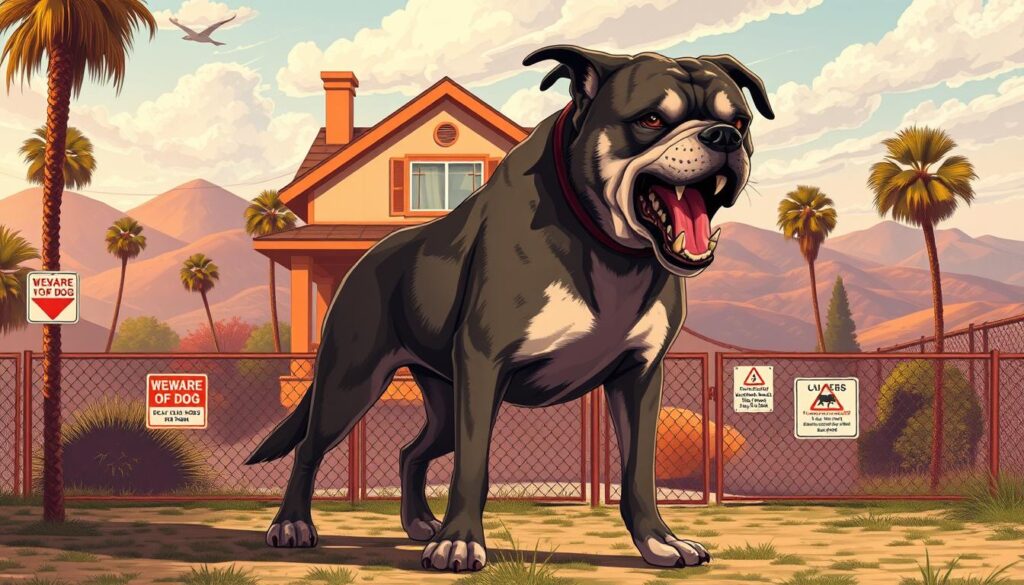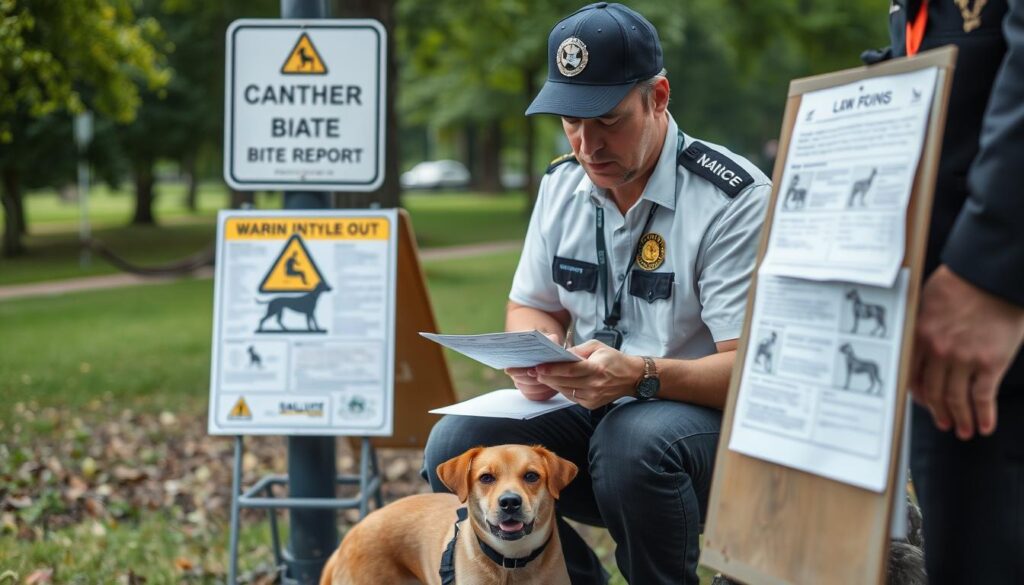If you own a pet in California, it’s important to know the dangerous dog laws. These rules help keep everyone safe and make sure owners and the public know their roles. By learning these laws, you can take care of your dog and follow the rules.

Key Takeaways
- California’s dangerous dog laws classify dogs into distinct categories, each with its own set of requirements and restrictions.
- Dog owners must comply with strict containment, control, and insurance regulations to prevent incidents and protect the public.
- Reporting and investigation processes are in place to address concerns and ensure proper enforcement of the law.
- Penalties for non-compliance can include civil fines, criminal charges, and even the seizure or euthanasia of the dog.
- Dog owners have legal rights and recourse during administrative hearings and appeals processes.
Overview of California’s Dangerous Dog Classifications
In California, dogs are grouped into different categories based on their behavior. Each category has its own rules for dog owners. Knowing these categories is key for keeping pets safe and protecting the public.
Understanding Potentially Dangerous Dogs
A potentially dangerous dog is a dog that has bitten or attacked someone without being provoked. It has caused a less serious injury. Or, it has acted in a way that makes people think it might attack. Owners of these dogs need to be extra careful and watch their pets closely.
Definition of Vicious Dogs
A vicious dog is one that has done something very serious. It has seriously hurt or killed someone without being provoked. These dogs have to follow very strict rules. If they don’t behave, they could even be put down.
Legal Distinctions Between Classifications
The laws for potentially dangerous and vicious dogs are different. This affects what owners must do and what they might face. Owners of potentially dangerous dogs might get fined or have to take obedience classes. But, owners of vicious dogs could face serious legal trouble, strict rules, and even have their dog taken away or put down.
| Potentially Dangerous Dog | Vicious Dog |
|---|---|
| Bite or attack that causes less severe injury | Severe injury or death of a person without provocation |
| Behavior that a reasonable person would believe poses a risk of attack | Engaging in more serious, dangerous behavior |
| Owners face fines, mandatory training, and other measures | Owners face criminal charges, strict containment rules, and potential dog seizure or euthanasia |
“Understanding the legal definitions and distinctions between potentially dangerous and vicious dogs is crucial for dog owners in California, as it directly impacts their responsibilities and the consequences they may face.”
California Dangerous Dog Law: Essential Regulations and Statutes
If you own a pet in California, you need to know the state’s laws about dangerous dogs. These laws, called the California Dangerous Dog Law, explain what makes a dog dangerous. They also talk about what owners must do and the penalties for not following the rules.
The California dog statutes divide dogs into two groups: potentially dangerous dogs and vicious dogs. Potentially dangerous dogs might have attacked someone or another animal without being provoked. Vicious dogs have caused serious harm or death. Each group has its own rules and consequences for owners.
| Potentially Dangerous Dog | Vicious Dog |
|---|---|
| Unprovoked attack on person or animal, causing minor injury | Infliction of severe injury or death on a person |
| Strict owner requirements, including insurance and containment | Potential for dog seizure and euthanasia |
California also has local dangerous animal laws that add to the state’s rules. These pet legislation laws vary by city or county. Dog owners must follow both state and local laws to avoid trouble.
It’s important for dog owners to know the California Dangerous Dog Law well. This knowledge helps keep pets safe and communities safe too. By understanding the law, owners can make sure they’re doing the right thing for their dogs and everyone else.
Owner Responsibilities and Legal Obligations
Being a responsible dog owner in California means knowing the law. These rules help keep everyone safe, including your dog.
Required Insurance Coverage
Owners of dangerous dogs must have pet insurance coverage. California law says they need at least $100,000 in liability insurance. This is to cover any injuries or damages their pets might cause. Not having this insurance can lead to big problems for the owner.
Containment and Control Requirements
Keeping dangerous dogs under control is a must. California rules say these dogs must be in locked, secure places when not with their owners. They also need to be on a strong leash and under control in public.
Registration and Licensing Procedures
Registering and licensing your dog is also important. This is especially true for dangerous or vicious dogs. It helps local authorities keep track of your dog and its history, making everyone safer.
Following these owner responsibilities and legal obligations keeps your community safe. It also protects your dog.
“Responsible dog ownership is not just a moral obligation, but a legal one in California. Failure to comply with these regulations can have serious consequences.”
Reporting and Investigation Process
In California, it’s key to report and investigate dangerous dog incidents to keep everyone safe. If a dog bites, attacks, or shows bad behavior, it’s important to tell the right people.
The first thing to do is contact the local animal control or law enforcement agency and file a report. This starts an investigation into the dog’s behavior and history. Animal control and law enforcement will look into it.
- The team will collect info about the incident, like the dog, its owner, and any harm done.
- They’ll also check the dog’s bite history and any past complaints or incidents.
- Then, they’ll classify the dog as potentially dangerous, vicious, or not a threat, based on California’s laws.
This detailed investigation process helps figure out what to do next. This might include requirements for the dog’s owner, like liability insurance, proper containment, and training.

By reporting dangerous dog incidents and working with animal control investigations, we all help keep our community safe. This is how we address dangerous dog complaints and ensure public safety.
Penalties and Consequences for Non-Compliance
Breaking California’s dangerous dog laws can lead to serious penalties for pet owners. These rules are in place to keep everyone safe and encourage dog owners to be responsible. Let’s look at the different penalties for not following these laws.
Civil Penalties
Owners of potentially dangerous or vicious dogs can face big fines from animal control. These dog law violations can cost from $100 to $1,000 per offense. Not following rules on registration, insurance, or keeping the dog contained can also lead to big animal control fines.
Criminal Charges
In serious cases, owners of dangerous dogs might face criminal charges. If a vicious dog attacks or injures someone, the owner could get misdemeanor or felony charges. This could mean fines up to $10,000 and jail time. The owner might also have to pay for medical bills or damage caused by their dog.
Dog Seizure and Euthanasia Guidelines
Authorities can take and possibly kill dogs that are a big threat to the public. Dangerous dog seizure might happen if an owner doesn’t follow court orders or if the dog attacks badly. Killing a dog is usually the last option, for dogs that are too risky for public safety.
Understanding California’s dangerous dog laws is key for responsible pet ownership. Knowing the penalties helps dog owners stay in line and keep the community safe for everyone.
“Responsible dog ownership is not just a choice, it’s a duty we owe to our pets and our community.”
Rights of Dog Owners During Legal Proceedings
As a dog owner, knowing your legal rights is key when facing dog-related allegations. California’s animal law hearings offer a fair way for pet owners to defend their pet owner legal rights.
If your dog is seen as potentially dangerous or vicious, you can ask for a formal hearing. This hearing lets you show evidence, call witnesses, and dispute the dangerous dog label. It’s a crucial step in defending your rights and getting a fair result.
- You have the right to receive written notice of the hearing, including the specific allegations and proposed actions.
- During the hearing, you can be represented by an attorney, who can advocate on your behalf and challenge the evidence presented by the authorities.
- The hearing officer must consider the totality of the circumstances, including the dog’s behavior, past incidents, and any mitigating factors, before making a determination.
If the dog is found dangerous or vicious, you can appeal the decision. This appeals process offers another chance to review the case, allowing you to present new evidence or challenge the initial ruling.
“Navigating the legal system can be daunting, but the rights afforded to dog owners are designed to ensure a fair and balanced outcome.”
Remember, as a responsible dog owner, you have the right to defend your pet and challenge any dangerous dog allegations. By understanding the legal process and exercising your rights, you can protect both your canine companion and your own dog owner legal rights.
Prevention Measures and Safety Requirements
Being a responsible dog owner means more than just following the law. It’s about keeping your dog safe and the community safe too. By using dog safety measures, pet containment, and training, owners can lower the risk of accidents. This helps everyone live together peacefully.
Required Signage and Warnings
In California, dog owners must post clear warnings about dangerous dogs. These signs must be seen from the street. They help keep people safe by warning them to be careful.
Proper Fencing and Containment
Having the right fencing is key for dog owners. California’s laws require strong enclosures to keep dogs in. This keeps pets safe and prevents them from causing trouble.
Training and Behavioral Modification
Training is important for dogs, not just to follow the law. Working with experts can change a dog’s behavior for the better. This makes the dog safer and strengthens the bond between dog and owner.
| Preventive Measure | Benefit |
|---|---|
| Required Signage and Warnings | Alerts the public to the presence of a potentially dangerous dog, allowing for increased caution and awareness. |
| Proper Fencing and Containment | Ensures the dog remains securely on the owner’s property, preventing unauthorized access or escape. |
| Training and Behavioral Modification | Addresses any aggressive tendencies and promotes positive, non-violent behaviors in the dog. |
By taking these steps, dog owners in California can meet their legal duties. They also keep their dogs and the community safe. This makes everyone’s life better.
Victim Rights and Legal Recourse
In California, if a dog attacks, the law helps dog bite victims get justice and money. People hurt by an animal can sue the dog’s owner. This is for injuries or damage to property.
The state’s strict liability law makes dog owners responsible for their pets. This is true even if the dog has never been aggressive before. So, animal attack compensation can be sought, even without a history of aggression.
- Victims can get money for medical bills, lost work, pain, and other damages.
- Dog owners might also face criminal charges if the dog’s actions caused serious harm or death.
- Victims can report the incident to the police and help with the investigation. This can prove who is at fault and support their personal injury claims.
It’s crucial for dog bite victims to document everything well. They should also get legal advice to protect their rights and get fair compensation. The legal process can be hard, but with the right help, victims can make irresponsible dog owners pay.
| Legal Recourse for Dog Bite Victims | Description |
|---|---|
| Personal Injury Claim | Victims can pursue compensation for medical expenses, lost wages, and other damages resulting from the dog attack. |
| Criminal Charges | Dog owners may face criminal charges if their animal’s actions resulted in serious injury or death. |
| Reporting and Investigation | Victims have the right to file a report and participate in the investigation, which can support their legal claims. |
By knowing their rights and legal options, dog bite victims in California can take action. They can make sure irresponsible dog owners are held accountable and get the compensation they deserve.

“Responsible dog ownership is not just a moral obligation, but a legal requirement in California. When that duty is breached, victims have the right to seek justice through the courts.”
Appeals Process and Administrative Hearings
If you disagree with your dog being called “potentially dangerous” or “vicious,” you can appeal. This is a key step to show your pet’s good side. It lets you share evidence and fight for your pet’s rights.
Timeline for Appeals
You have 10 to 14 days after your dog is labeled as dangerous to ask for a hearing. It’s important to act fast. This way, you can protect your pet and your rights.
Required Documentation
To start the appeal, you need to fill out forms and gather documents. These include a request for a hearing and any medical or behavioral records. A pet law attorney can help make sure you have everything you need.
Legal Representation Options
Having a lawyer is not required but it can help a lot. A skilled pet law attorney knows California’s laws well. They can help you through the hearing, fighting for your dog’s rights.
FAQ
What is the purpose of California’s dangerous dog laws?
California’s dangerous dog laws aim to keep people safe. They set rules for dog owners of potentially dangerous or vicious dogs. These laws help keep communities safe and hold owners accountable for their pets.
How are dangerous dogs classified under California law?
California law splits dogs into two groups: “potentially dangerous dogs” and “vicious dogs.” Potentially dangerous dogs show aggressive behavior. Vicious dogs have caused serious harm or death. The law’s rules differ based on these classifications.
What are the key regulations for dangerous dog owners in California?
Owners of dangerous dogs in California must follow several rules. They need liability insurance, must keep their dogs contained, and register them. They also have to follow local laws about dangerous dogs.
What are the legal responsibilities of dangerous dog owners in California?
Owners of dangerous dogs in California face big responsibilities. They must have insurance, keep their dogs under control, and register them. Not following these rules can lead to fines, criminal charges, or even the dog being taken away.
How are dangerous dog incidents reported and investigated in California?
If a dangerous dog incident happens, it must be reported to animal control or police. An investigation will then take place. The dog’s classification is decided based on the incident’s details and severity.
What are the potential penalties for non-compliance with California’s dangerous dog laws?
Breaking California’s dangerous dog laws can lead to serious penalties. Owners might face fines, criminal charges, or even have their dog taken away. The exact penalty depends on the violation’s severity and any past offenses.
What legal rights do dog owners have during dangerous dog proceedings?
Dog owners facing dangerous dog allegations in California have rights. They can appeal classifications, participate in hearings, and present evidence. They can also get legal help to defend themselves against dangerous dog designations.
What preventive measures can dangerous dog owners take to ensure compliance?
To follow California’s dangerous dog laws, owners should take steps like installing signs and containment systems. They should also train their dogs and work on their behavior. These actions can prevent incidents and legal trouble.
What legal recourse do victims of dangerous dog incidents have in California?
Victims of dangerous dog attacks in California can seek compensation. They can file injury claims, get support, and sue the dog’s owner for not following the law.
What is the appeals process for dangerous dog classifications in California?
Owners can appeal a dangerous dog classification through hearings. They need to submit documents and follow timelines. Getting legal help is often necessary. The outcome can affect the owner’s responsibilities and the dog’s future.
